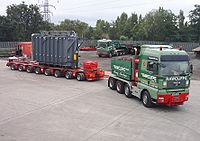
Back Abschleppen German Remolcar Spanish یدککشی Persian Remorquage French Penderekan ID Kişandin Kurdish Tractare auto Romanian Буксировка Russian Bogsering Swedish Буксирування Ukrainian
This article needs additional citations for verification. (August 2021) |
Some of the image captions in this article may require cleanup to comply with Wikipedia guidelines for establishing an image's relevance to the article. (August 2021) |


Towing is coupling two or more objects together so that they may be pulled by a designated power source or sources. The towing source may be a motorized land vehicle, vessel, animal, or human, and the load being anything that can be pulled. These may be joined by a chain, rope, bar, hitch, three-point, fifth wheel, coupling, drawbar, integrated platform, or other means of keeping the objects together while in motion.
Towing may be as simple as a tractor pulling a tree stump. The most familiar form is the transport of disabled or otherwise indisposed vehicles by a tow truck or "wrecker". Other familiar forms are the tractor-trailer combination, and cargo or leisure vehicles coupled via ball or pintle and gudgeon trailer hitches to smaller trucks and cars. In the opposite extreme are extremely heavy duty tank recovery vehicles, and enormous ballast tractors involved in heavy hauling towing loads stretching into the millions of pounds.
Necessarily, government and towing sector standards have been developed for carriers, lighting, and coupling to ensure safety and interoperability of towing equipment.
Historically, barges were hauled along rivers or canals using tow ropes drawn by men or draught animals walking along towpaths on the banks. Later came chain boats. Today, tug boats are used to maneuver larger vessels and barges, and offshore and salvage tugs are used to tow unpowered or disabled vessels over long distances. Over thousands of years the maritime field has refined towing to a science.
Aircraft can tow other aircraft as well. Troop and cargo-carrying gliders were towed behind powered aircraft, which remains a popular means of getting modern leisure gliders aloft.
